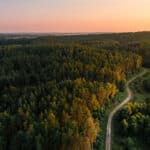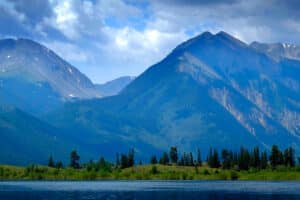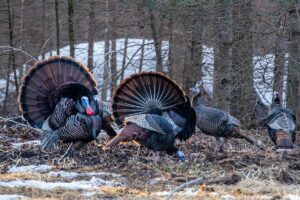Wal-Mart is not often celebrated as a leader in the environmental movement (though if you analyze its most recent efforts to green its operations, perhaps it is moving in the right direction). Nonetheless, Wal-Mart’s former CEO, Lee Scott, had it right when he stated in 2005, “Being a good steward of the environment and of our communities, and being an efficient and profitable business are not mutually exclusive. In fact, they are one and the same.”
As landowners are faced with innumerable questions about how to derive the most satisfaction from their land, this is a quote that should come readily to mind. Indeed, as more and more landowners are finding, instituting conservation-oriented practices has become a wildly lucrative option. It should come as no surprise, then, that despite the catastrophic effects of the Great Recession, land trusts have conserved over 10 million acres nationwide in the past five years, according to the national Land Trust Alliance.
For many landowners, however, the prospect of giving up any level of control over their land, whether through easements or enrolling in public programs, is not an attractive option. And for others, the tax benefits and annual payments may not cover their expenses. Luckily, for both of these groups, an incredible number of opportunities exists for generating revenue from instituting conservation-oriented practices.
Investing in outdoor recreation is one of these opportunities. In the Commonwealth of Virginia, hunting and fishing generate a combined $2.7 billion in economic activity each year. By consciously managing the land in order to promote the growth and preservation of wildlife habitat, clean water, and healthy populations of targeted species, landowners can position themselves to benefit from such economic activity through access permits and the like. By further investing in amenities like shooting stands and blinds, boating docks, and even guest lodging, landowners can establish their property as a prime destination for sporting enthusiasts.
Consider The Fork Farm & Stables in Stanly County, NC for example. When Jim Cogdell purchased the property in 1999, he did so with the intent of renewing, conserving, and preserving the natural beauty of the land. Having committed to land and wildlife conservation while still operating the property as a working farm, Cogdell has established The Fork as a premiere sporting destination, with amenities including shooting facilities, fishing, equestrian facilities and trails, hiking and biking trails, golf, and outdoor education programming.
For those not interested in visitor fees as a source of revenue, another option to consider is the monetization of ecosystem services. As requirements for protecting stormwater quality and quantity, air pollution, and biodiversity continue to become ever more stringent, developers, localities, and corporations are searching high and low for ways to offset the environmental impacts of their activities. Indeed, according to the Ecosystem Marketplace, wetland mitigation credits prices range anywhere from $3,000 to $600,000 per acre of wetland, with the prices rising every year. On a broader scale, the wetland mitigation market, biodiversity markets, and forest carbon markets are all setting new records each year.
Though the sale of these credits typically requires fairly large, continuous tracts of lands, opportunities do exist for landowners of smaller properties to benefit financially from the ecosystem services on their lands. In 2004, the Blue Ridge Forest Cooperative was formed as a method for giving smaller timberland owners from North Carolina, Tennessee, Virginia, and West Virginia greater access to local and national timber markets. The Cooperative has been immensely successful and has enabled its members to sell over 12 different wood products to markets they had not previously had access to. Further, in an effort to realize the full value of the members’ lands, the Cooperative is laying the groundwork for entering the markets for carbon and stream restoration credits.
If generating revenue from ecosystem services doesn’t suit a landowner’s fancy, he or she can always consider a residential development. More specifically, a conservation community. Conservation communities are residential developments that, logically, are designed with a central focus on conserving the land in order to maintain its rural character. Housing sites are chosen with an eye toward taking advantage of views without being visible themselves. Roads and driveways are designed to be as unobtrusive as possible. And stormwater is managed through low impact development rather than through traditional drains and pipes. When properly designed, conservation communities provide residential options while simultaneously minimizing the impact on the land.
Bundoran Farm serves as a prime example of just such a development. Located on 2,300 acres, this area was designed to function in harmony with a working farm while providing 102 home sites, each ranging in size from 2 to 150 acres for a total disturbance of only 20% of the original property. The construction costs for the development were significantly reduced compared with traditional residential developments due to reduced road widths and the use of vegetated swales rather than traditional curbs and gutters. As a result of the efforts to preserve the land and provide a high quality of life for residents, the development’s stakeholders have enjoyed increased property prices, with lots selling for between $250,000 and over $1 million.
The potential financial benefits of investing in conservation are clear. Whether a landowner chooses to solicit public or private sources of funding, they have a wide range of options from which to choose. In many cases, the best approach can even involve generating revenue from both sets of funding sources. For example, a landowner can receive cost-sharing payments for protecting wildlife habitat and then can sell hunting permits to those wishing to access that habitat. Regardless of the approach taken by a landowner, ensuring the economic viability of his or her land is a key step in achieving genuine sustainability. As Verilyn Klinkenbord, author of Crossing Borders: Good News from the Badlands, wrote, “Many have said, ‘The land must be productive.’ By saying this, they aren’t just articulating an old-fashioned view about man’s dominance over nature. They are arguing for what one neighbor calls ‘working wilderness.’ They are saying that unless there is some economic return to the land, there is no defense at all against the pressures of development, which are spiraling outward from nearly every city and small town in the West.”
This content may not be used or reproduced in any manner whatsoever, in part or in whole, without written permission of LANDTHINK. Use of this content without permission is a violation of federal copyright law. The articles, posts, comments, opinions and information provided by LANDTHINK are for informational and research purposes only and DOES NOT substitute or coincide with the advice of an attorney, accountant, real estate broker or any other licensed real estate professional. LANDTHINK strongly advises visitors and readers to seek their own professional guidance and advice related to buying, investing in or selling real estate.









Michael,
Great points about benefits of investing in conservation. This is also true in farmland operations such as using waterways and building buffers near water sources.
Thanks for the comment, Marisa!
I absolutely agree. As we continue to shine a light on the various economic incentives associated with investing in conservation, the more likely landowners will be to disregard existing stigmas regarding the “costs” of adopting sustainable practices.
Great article Michael. I particularly liked your real life examples where developers and investors are putting their money where their mouth is! Here’s another example…
Can an investment help the pocketbook and the planet at the same time?
Definitely, says R. Paul Herman, author of The HIP Investor: Making Better Profits by Building a Better World. Following is an excerpt from Herman’s book. Explore the options, and put your money on a wiser course…
“What frameworks are useful in evaluating real estate investments? The Sustainable Land Development Initiative (SLDI), a member-owned organization dedicated to promoting land development around the world, seeks to balance the needs of people, planet and profit – for today and future generations. SLDI is piloting a project at Ocean Mountain Ranch in Oregon using The SLDI Code (based on a holistic model) to pioneer innovations in eco-forestry and sustainable living” – http://www.triplepundit.com/2011/02/fractal-frontier/
Thanks for directing me to that, Terry. Your property at Ocean Mountain Ranch looks like it is another perfect example of the many ways in which landowners are finding innovative ways to generate value from conservation practices.
For other readers less familiar with the important work he and SLDI are doing at Ocean Mountain Ranch, check out this video featuring Terry giving a great overview of their efforts: https://vimeo.com/27059270